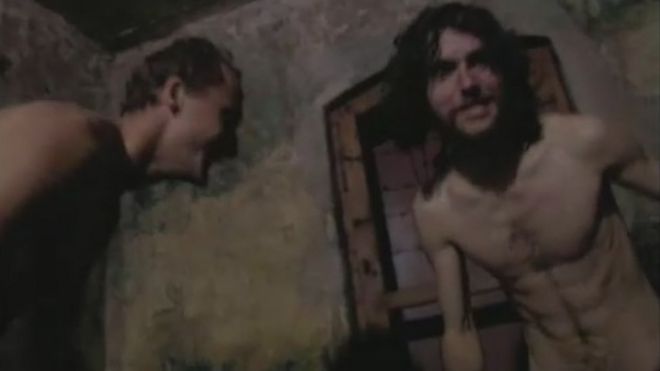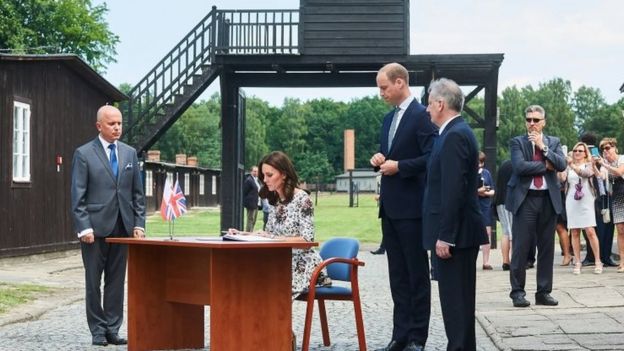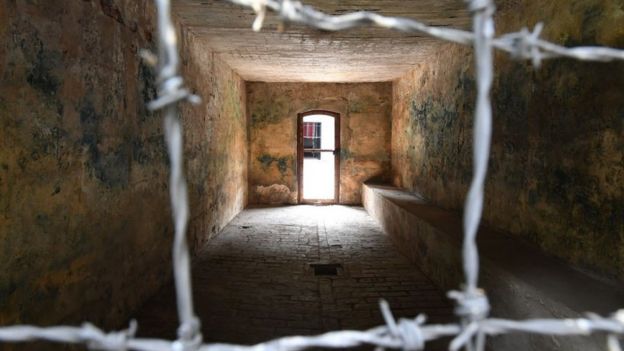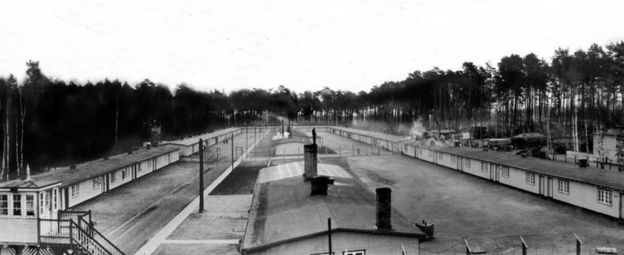 |
| Jewish groups want senior Polish officials to condemn the video |
Holocaust survivor groups have asked the Polish president to explain how artists were able to film a naked game of tag inside a Nazi camp gas chamber.
The film shows men and women running around laughing at the former Stutthof camp, where 65,000 people were killed.
Game of Tag, shot in 1999 by Artur Żmijewski, was exhibited in Krakow in 2015 despite Israeli objections.
But the filming location was not known until this year, following a visit by the British Royal Family.
Experts compared footage from the Duke and Duchess of Cambridge's visit to Stutthof and its gas chamber with the Polish video.
In their letter, groups including the Simon Wiesenthal Center, which investigates Nazi war criminals, and the Center Organization of Holocaust Survivors in Israel asked President Andrzej Duda if Mr Żmijewski had had permission to make the film and whether there were rules of conduct at Stutthof.
They also asked President Duda to "clearly, properly condemn this so-called artwork".
 |
| The Duke and Duchess of Cambridge's visited Stutthof in July |
"It's really outrageous. I hope the Polish president will put in place regulations to make sure stuff like this doesn't happen again," the Wiesenthal Center's chief Nazi hunter Efraim Zuroff told the BBC.
"It was banned in Germany, Estonia took in down when we contacted them. In Poland for some reason, which lost six million people - three million Jews and three million Poles - they didn't get it," he added.
Jerusalem-based lawyer David Schonberg first noticed that Mr Żmijewski's video was shot in Stutthof after noticing that footage from William and Catherine's visit in July showed the same stains on the walls, ledge along one side, plughole in the centre and doors at each end.
Experts at the Yad Vashem Holocaust Memorial in Jerusalem confirmed the finding.
 |
| Experts compared footage from the royal visit to the video |
Mr Schonberg told the BBC that more important than the video itself was the "apparent indifference" to it in Poland.
"This is a problem that needs to be addressed. If people are not sufficiently sensitive to the terrible acts of the Holocaust and do not respect its victims then proper conduct in the sites in Poland cannot be properly secured," he said.
"This also requires proper scrutiny of these sites and making sure that objectionable materials that are so insensitive to the memory of the Holocaust will not be brought on public display."
Mr Schonberg said the video's reception in Poland was particularly hard to understand as the majority of those who died at Stutthof were Polish non-Jews.
The 2015 Krakow exhibition, Poland-Israel-Germany - The experience of Auschwitz, was sponsored by the Israeli embassy, which then called for part of the video to be removed after Jewish groups protested. But the Krakow Art Museum said it should be shown because it was a matter of freedom of expression.
A description of Mr Żmijewski on the Warsaw Art Museum's website states that the people in the video are having fun, "but they are also very serious. They know where they are - in the gas chamber of a former Nazi extermination camp".
The Baltic death camp where thousands perished

- Stutthof was the first Nazi camp set up outside German borders, established in September 1939
- It was originally used for the imprisonment of the "undesirable Polish elements"
- By 1942 it had become a concentration camp and grew to include 39 sub-camps which housed 110,000 men, women and children over its five years
- Some 65,000 inmates - including 28,000 Jews - were killed by lethal injection, gas chamber, shooting and hanging, as well as disease and malnutrition
- Stutthof was the last camp to be liberated - on 9 May 1945 by the Soviet Army
Source: BBCNews

No comments:
Post a Comment
Add a Comment...